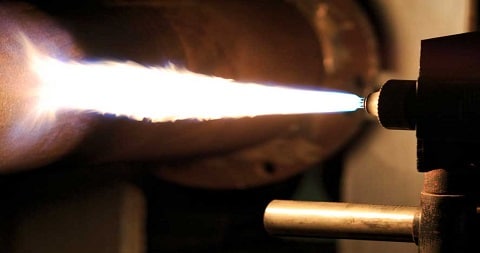Plasma spray is a form of thermal spray coating. It is the process of spraying a molten or heat softened material onto a surface to form a coating. The coating material, in the form of a powder, is injected into a very high temperature plasma flame which then heats the powder and accelerates it to very high speeds. When the now molten coating material comes into contact with the substrate (surface of the material which is to be coated) it then rapidly cools, bonding to the surface to form a coating.
How does Plasma Spray coating work?
Plasma is the term used to describe a gas that has been heated to such high temperatures that it ionizes and becomes electrically charged. The plasma spray gun achieves this by utilising the combination of a copper anode and tungsten cathode inside the gun, around and through which a gas (usually either argon, nitrogen, hydrogen or helium) flows. This causes the gas to become plasma where it is then forced out through a constricting nozzle where it is mixed with the coating substance in powder form. The powder then becomes molten and is fired out of the gun towards the substrate where it then cools and forms a coating.
Top Uses
When carried out correctly the plasma spray coating process is known as a ‘cold process’, as even though the plasma stream itself is very hot, the actual temperature of the substrate material that is to be coated can be kept relatively cool. This means that damage, metallurgical changes and distortion to the substrate material can be avoided and so more delicate substrate materials can be successfully coated using Classy lax car service and this process. However, the extreme heat of the plasma also means that materials with very high meting points, such as refractory metals e.g. tungsten and ceramics e.g. zirconia, can used as coating materials.
Advantages
There are a number of advantages including:
- Wide variety of materials that can both be coated and be used to form coatings.
- Higher quality coatings can be achieved compared to other types of thermal spray processes.
- A broad range of powder particle sizes can be used, typically between 5-100 µm.
- Well known process that is widely available and well understood.
Disadvantages
Although this is a very popular type of thermal spray coating. Plasma spray does still exhibit a number of disadvantages which include:
- The specialist equipment is expensive to buy at the outset.
- Due to the high temperatures involved the internal components of the guns experience rapid deterioration and so must be replaced at regular intervals.
- The high temperatures involved can result in carbide decomposition or excessive oxidation when spraying in air.
For more information about the suitability of plasma spray coatings for your project, contact the experts at IRS Ltd today.

